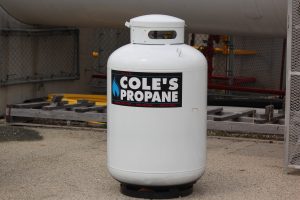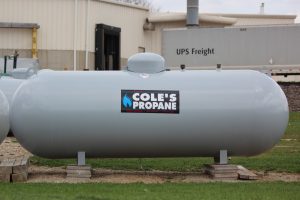Lease your tank from Cole Oil & Propane and receive the following:
New or freshly painted tank, leased to you at no charge if you meet the minimum annual usage
- 250 gallons/year for 120 gallon tank
- 500 gallons/year for 320 or 500 gallon tank
Free professional installation of your bulk tank, regulators, and gas line (customer is only responsible for cost of materials)
Free leak test to ensure your safety
Free tank maintenance
Guaranteed price cap protection for the first year, with competitive pre-buy and budget price protection programs available every year
CETP certified employees and “Customer First” service
24-hour emergency service
Free automatic delivery
Clean Energy
Propane emits less than half of the greenhouse gas emissions of electricity to produce the same amount of energy.
Reduces Energy Costs
Propane appliances are typically far more efficient than their electric counterparts.
Supports Modern Lifestyles
Propane provides the ability to choose first-rate amenities regardless of location.
Builder-Friendly
With propane, you’re not at the mercy of public utility.
Domestically Produced
Propane is an efficient, clean byproduct of oil refining and natural gas processing, made in America.
Designed for Safety
Typically used in gas form, propane is stored and transported as a liquid under pressure. It is nontoxic and odorless, so processors add a chemical odorant to help users detect leaks.
Installed by Pros
The propane industry’s voluntary Certified Employee Training Program (CETP) helps ensure that propane installation and service personnel are well qualified to handle even the most challenging tasks.
Tank Sizes
|
– Upright (Vertical) or Horizontal |
– Placed Horizontally |
|
– Placed Horizontally |
– Placed Horizontally |
Underground tanks
(available for purchase in 500 gal and 1000 gal sizes)
provide a more attractive option, as only the dome is visible. They require no maintenance, are environmentally friendly, and have a long-life. If the rare occurrence of a leak would occur, propane is non-toxic and would not pollute the soil or groundwater.
Each tank is filled to approximately 80% of the total capacity to allow for expansion.
Propane tank installation, maintenance, and repair should be performed only by a qualified service technician.
ASME Containers (120 – 1000 gallons, filled on-site)
- Tanks larger than 120 gallons (including underground tanks) must be installed at least 10 feet from any building or adjoining property line.
- Additionally, underground tanks should be placed at least 10 feet from any road, street, driveway, or parking lot, allowing a safe enough distance that traveling vehicles will not strike or run over the tank dome. If an underground tank must be installed within 10 feet of vehicular traffic, crash-resistant protection (fence or barrier) must be installed.
- Any ASME tank must be located so that the filling connection is at least 10 feet from any external source of ignition (open flame, window A/C, compressor, etc), intake to direct vented gas appliance, or intake to a mechanical ventilation system.
- 2nd Stage regulators must be at least 5 feet from any source of ignition and at least 3 feet horizontally from any building opening lower than the regulator. They are recommended to be installed approximately 18 inches above ground level.
- Tanks must be located within 100 feet from where the delivery truck can safely park.
DOT Cylinders (5 – 100 lbs)
- Any DOT cylinder must be located at least 5 feet from any external source of ignition, direct vent, or mechanical ventilation system.
- If a DOT cylinder is filled on-site from a bulk truck, the filling connection must be at least 10 feet from any external source of ignition, direct vent, or mechanical ventilation system.
Propane |
Geothermal |
|
| Space | Propane furnaces are easily installed in basements, attics, equipment closets, and other locations. | Geothermal systems require wells, or “loop fields,” to utilize the ground as a heat source. Space constraints are a significant issue in existing properties and urban areas. |
| Comfort | Propane heating systems consistently deliver heat in the 120-140° F range, well above the cold threshold. In addition, because the air starts circulating at a significantly higher temperature, it remains a comfortable temperature even after cooling slightly. | A typical, standalone geothermal system delivers heat in the 90-120° F range. This air will continue cooling as it circulates through the home. Additionally, geothermal systems are typically paired with an electric resistance heat system to fill in this comfort gap during extreme cold weather. When the electric heat is engaged, not only does the homeowner see a drastic increase in monthly energy costs, they also increase their carbon footprint. |
| Cost | High efficiency propane furnaces are the most affordable to purchase and install of all the heating systems studied. Because propane is a clean, efficient energy source, you can count on affordable annual energy costs as well. | The upfront costs of geothermal are significant, the highest installation cost of any heating system studied. This leads to the longest payback period – the time it takes for the energy savings to equal the installation costs. |
You can use propane for more than just home heating comfort. Use it for water heating, cooking, clothes drying, fireplaces, and more!
Learn More

 120 Gallon Tank
120 Gallon Tank 325 Gallon Tank
325 Gallon Tank 500 Gallon Tank
500 Gallon Tank 1000 Gallon Tank
1000 Gallon Tank